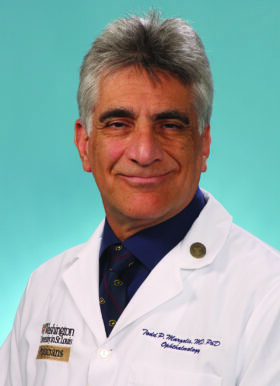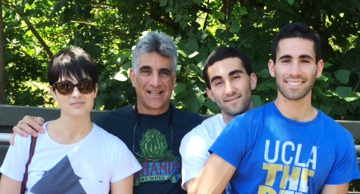Todd Margolis, MD, PhD

Todd Margolis, MD, PhD, is the Alan A. and Edith Wolff Distinguished Professor and Chairman, ophthalmology and visual sciences. His areas of specialty include infectious and inflammatory eye diseases, corneal disease, and uveitis.
Dr. Margolis sees patients at:
- Barnes-Jewish Center for Outpatient Health, 4901 Forest Park Ave., 6th Floor, St. Louis, MO 63108.
Please call 314-362-3937 for an appointment.
What happened in the course of schooling to influence you to choose your specialty?
I came about choosing my specialty quite late in my schooling. I had a PhD in neuroscience and was going down the path to be a neurologist, but friends in ophthalmology encouraged me to look into doing a clinical rotation in ophthalmology, I did — and found I loved it.
The field of ophthalmology is both medical and surgical. The doctor is able to look into the eye and actually see the pathology to figure out what is happening with the patient.
I saw this as an opportunity to bring together research and clinical care in the area of infectious and inflammatory diseases of the eye. There are many diagnostic dilemmas in this specialty – infections or disease in other parts of the body can also affect the eye. It’s challenging to use the clues the body gives to figure out exactly what is going on.
What are some examples of how an infection of the eye can be affected by something happening elsewhere in the body?
A patient with AIDS can have opportunistic infections of the eye that are related to AIDS. A bone marrow transplant patient who has graft-versus-host disease may have inflammatory conditions of the eye.
In addition, a patient with an autoimmune disease that affects other parts of the body, like rheumatoid arthritis can have associated can have associated ocular inflammation. Someone who has asthma or eczema is much more prone to getting herpes simplex infections of the eye.

What brought you to Washington University?
I came here in early 2014, so I’m fairly new. I had a wonderful job at University of California San Francisco (UCSF). I had been there my entire career and was very happy.
However, the opportunity arose to come to Washington University and it was a chance to work with many like-minded individuals — it is a clinician scientist’s heaven.
Also, it was very appealing to lead a department that was extremely strong, but with room to be even stronger by taking advantage of the rest of the strengths on campus.
Which aspect of your practice is most interesting?
I would say the diagnostic challenges of the whole spectrum of infectious and inflammatory eye disease are most interesting – and more specifically, diagnosing and treating herpes infections of the eye, including herpes simplex, herpes zoster (shingles) and cytomegalovirus.
I enjoy taking care of patients with herpes infections of the eye because when they are properly taken care of, they do extremely well.
Another condition I like treating is ocular surface disease. It is actually a grab bag of different infections that have been thrown into one category, and frequently misdiagnosed as dry eye. The eyes might feel dry, but are actually not dry at all. It’s rewarding to make a correct diagnosis that may even reduce the amount of medication a patient must take.
What new developments in your field are you most excited about?
There have been huge advances in the way we understand and manage macular degeneration. Down the road, there will be even more therapeutic approaches that will dramatically change the course for patients losing their vision.
In the area of surgical ophthalmology, improved techniques will continue to be developed to visualize and treat disease, especially through the use of lasers.
New technologies are making both our diagnostic abilities and therapeutic interventions much better than they have been in the past.
The future looks exciting for gene therapy and stem cell regenerative work in the eye. Currently there are clinical trials in gene therapy for inherited retinal diseases. We are able to find and replace the gene to treat or prevent the disease.
Stem cell regeneration in the eye is also promising because the eye is very accessible and we can easily determine the effects and the outcome.
Are we seeing more macular degeneration because people are living longer?
Absolutely. We have an aging population and we are going to see more and more macular degeneration and glaucoma – conditions that weren’t as common when people didn’t live as long as they do today.
There are additional risk factors for macular degeneration such as smoking and ultraviolet light exposure. Naturally, the longer someone lives, the greater the exposure risk.
It is a huge impact on independence and quality of life when someone has to quit driving because of vision loss.
Where are you from?
I grew up in southern California and went to northern California for college (Stanford) and medical school (University of California, San Francisco). I lived in northern California from 1973 until I moved here.
St. Louis is not California, but I really like it here. Despite what people who live here think, there is actually very little traffic — my commute time is almost nothing. I used to live 17 miles away from work and it could take over an hour to get home — pretty frustrating at the end of a long work day.
I love the people in St. Louis, they are wonderful. Of course there are certain things we miss – the ocean, the mountains and California wine country.
When I moved here, I took a bigger job with more responsibilities, but my stress level went down.
Is there a particular award or honor that is most gratifying?
It is gratifying when the patient says, thank you, I feel better, I see better. That is much more important to me than any awards. Even if the outcome is not as successful as we wanted, the patient knows I am trying and thanks me for my efforts. That means a lot to me.
But if I were to pick one award, it would be when I had the opportunity to give the Thomas H. Pettit Endowed Lecture at UCLA. Dr. Pettit was a legendary ophthalmologist who made many important contributions to the field. He was an absolute gentleman with the highest ethical standards, a wonderful person and a great physician. It was an honor to be chosen to give the annual lecture in his name.
What is the best advice you’ve received?
I never thought I would be in ophthalmology, much less treating infectious and inflammatory diseases of the eye. I also never thought I’d be in a leadership role in the field. It just wasn’t my goal and wasn’t on my radar.
I had a number of wonderful mentors over the years who taught me a great deal. Early in my training, when I was working on my PhD at UCSF, Dr. Pete Ralston, chairman of anatomy at UCSF, gave me the best advice. He said just get the best possible training you can, and later on you’ll figure out how to use it. So I sought out the best training, and opportunities to use it fell into place. He was right.
If you weren’t a physician or scientist, what would you like to be doing?
To be quite honest, I’m not sure what I’d be doing. Because what I’m doing now is what I want to be doing.